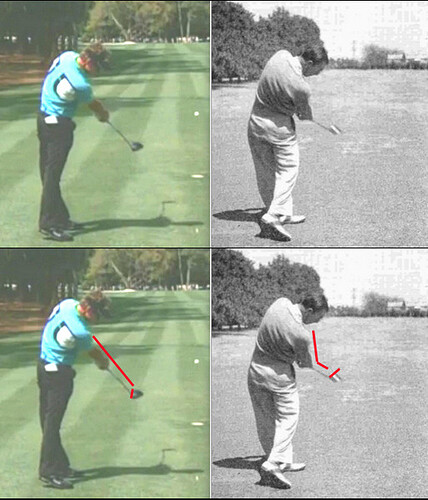TeddyIrons,
From my experience being both a hitter and formerly a swinger, and from the perspective of a tour player, the distinction between hitting and swinging should be in the hands.
Both Hogan and Snead often referenced “hitting with the right hand” Hogan also talked about “Hitting just as hard with the left hand”
In a nutshell I see it like this… the hands can either be passive hinges or active motors. I can drag the hands down from the top with the pivot,
and allow angular momentum to take over and automatically release the club. This is swinging. Relaxed hands also promote relaxed arms, and this is where we see the arms flying off the body post impact, out to right field.
Mac O’Grady once said “Swinging is out to right field, Hitting is around the corner”
That’s the cut it left stuff post impact… which works perfectly with a no roll or TGM “angled hinge”
With the dead or passive hand swinger’s protocol, there is little or no resistance to the outward pull of CF, so the clubface simply flips over because if the forces that be are unchecked, the clubface will seek a gravitational inline position with the shaft quickly past lowpoint. We see this as a full roll or TGM calls a horizontal hinge.
Now if the hands “HIT” actively, then that hit changes the path of the club and shaft, and starts the move left or around the corner. The hitter actually is in a fight with CF… trying to pull against it.
If you let go of a golf club at impact, the club will bounce off the ground and go off to your right towards right field. If we fire the hands and
keep the upper arms pinned onto the body, we are changing the direction of the golf club from it’s natural path.
So a common question would be, why would one want to do that? We’ll, for many reasons… First, you are going to actually keep the clubshaft on plane… Ask any of the guys here that are into module #4 and they will attest to the validity of this. It’s really quite a shock for most when they find out where true swing place actually is. Second… you can limit the amount of clubface rotation, and install an angled hinge action, which no doubt offers much better control of the golf ball. Third, this pull against CF puts feel into our hands… much more than if we are just dump slapping the club on the ball, and finally, hitting allows us the possibility to bring into impact a pre-stressed clubshaft into impact, which will be much more effective in resisting the forces of impact because to do so, you are introducing acceleration into the formula. Swingers do not have that option…swingers use a momentum strike, not a force strike. There is a difference… and it reads
f=ma hitters
p=mv swingers
p being momentum m being mass v being velocity a being acceleration f being force
Now you can call this stuff what you want, but from what I know about Lynn Blake who seems… for some reason to be the newly appointed expert of TGM, he teaches hitting to follow the same path as swinging, but instead of a passive hand and arm dump, he calls it a right arm hit, driving the right elbow actively with muscular force to an early both arms straight position post impact.
Now if you actually read The Yellow book and don’t just take Lynn Blake’s word for it… you might look at…
2-K at the bottom.
A Ball related release for swingers can be produced by using RIGHT ARM THRUST INSTEAD OF BODY MOMENTUM to resist clubhead slowdown during extension, if there is sufficient Clubhead inertia to restrict Lag pressure thrust to only extensor action application.
Lynn is simply confusing right arm active driving with a swinger’s option to drive actively with the right arm substituting a post impact pivot thrust with a right arm extensor action drive out to right field.
If he wants to call that hitting, fine… but the problem is that it looks exactly the same, so it’s nearly impossible to distinguish even if you are standing right infront of the player, or even watching it on video at 10K shutter speed. So his poster child Brian Gay, is doing this, or so he says, (I question this also) but Lynn is smart enough to set him up very upright on a shoulder plane and not down low on an elbow plane where he would be dealing with the shaft moving quickly off plane post impact. Gay’s upright impact swingplane is more along the lines of Moe, so he avoids the hazards of typical swingers problems.
Gay’s clubface closes pretty quick post impact, and is not angle hinging from what I can see, so this screams swinging to me. Moe’s face shut down quickly also, and this simply doesn’t happen with active firing hands. Then again Blake calls Moe a pure hitter so go figure.
The real hitting is what Mac and I would talk about, cutting left with an active hand strike, and this would be more inline also with the words of Hogan or Snead, or Mac, who have all voiced their opinions on what to call “a hit”
I actually tried to teach this to Paul Smith over a Skype session, showing the difference, but he is just too rooted in the Blake camp to even consider it as a possibility.
Here is a quote Paul made on the thread last month…

So why Paul? Why pin the arms on the body? How about so you can learn to hit the ball like Hogan for starters… 

This thread is called “Let’s Talk…” not “Let’s smoke and mirror everything to death.”


